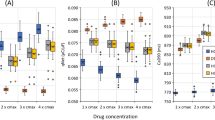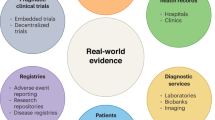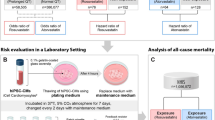Key Points
-
During the past decade, a number of non-cardiovascular drugs have had their label revised or have been withdrawn from the market because of unexpected post-marketing reports of sudden cardiac death associated with a prolongation of the QT interval on the surface electrocardiogram, and an increased propensity to develop a ventricular tachyarrhythmia called Torsades de Pointes (TdP). When corrected for individual heart rate, the QT interval is defined as 'corrected' QT, or QTc.
-
Although a direct link between QT interval prolongation and arrhythmogenesis is still unclear, QT prolongation is now the subject of increased regulatory review and is considered a significant risk factor for predicting human safety of new chemical entities (NCEs).
-
Any evidence that a new drug prolongs the QTc interval is a significant development concern for pharmaceutical companies, as it raises the apprehension of TdP, and its subsequent regulatory approvability. Furthermore, the focus of interpretation of QTc prolongation by non-cardiovascular drugs by worldwide regulatory agencies has changed from one of noted side effect to that of life-threatening fatal outcome.
-
There is at present no conclusive evidence to show that drug-induced prolongation of the QT interval inevitably leads to TdP. The link between QT interval prolongation and TdP is seemingly very complex and affected by a host of influential factors including age, electrolyte imbalance (for example, hypokalemia, hypomagnesemia and hypocalcemia), gender, disease states (for example, cardiomyopathy, myocardial ischaemia and infarction, hypertension, hypothyroidism, diabetes, renal or hepatic dysfunction) and concomitant medications.
-
Not all drugs that prolong the QT interval carry the same potential to induce TdP. Regulatory agencies are concerned that, for the majority of QT prolonging drugs, their arrhythmogenic potential was only recognized during post-marketing surveillance and/or often many months/years after they were approved and used in the clinic. As a result, regulatory agencies will continue to rely on QT interval prolongation as a surrogate indication for TdP.
-
In 1997, the European Agency for the Evaluation of Medicinal Products (EMEA) was the first to issue a 'points to consider' document from the Committee for Proprietary Medicinal Products. This document outlined a series of experimental non-clinical and clinical models for assessing the potential for QT prolongation by non-cardiovascular agents.
-
During the past two years, regulatory scrutiny has continued to increase with Health Canada issuing a detailed draft guidance entitled 'Assessment of the QT Prolongation Potential of Non-anti-arrhythmic Drugs'.
-
A preliminary concept paper for clinical testing entitled 'The clinical evaluation of QT/QTc interval prolongation and proarrhythmic potential for non-antiarrhythmic drugs' was recently issued by the Food and Drug Administration's Center for Drug Evaluation and Research, and Health Canada's Therapeutic Products Directorate.
-
A similar preclinical draft counterpart described as the S7B document and entitled 'Note for guidance on safety pharmacology studies for assessing the potential for delayed ventricular repolarization (QT interval prolongation) by human pharmaceuticals' is under review at present, and should be finalized by the end of this year. This document provides guidelines on suitable levels and methods of preclinical testing in order to further determine the potential for a drug to produce QT prolongation.
-
Developing a compound with a preclinical QT signal is not inconceivable, provided a carefully planned clinical development programme is adopted. However, millions of dollars in added research and development costs are at stake for such NCEs.
-
These costs eventually compel sponsors to carefully assess which diseases can be targeted and/or medications can ultimately be developed despite the need for therapies.
-
Once it is established that a drug has the potential to prolong the QTc interval at clinically relevant concentrations, a company must evaluate the approvability, labelling implications and consequent commercial fallout of such a NCE against the benefit of continuing development. Given these high hurdles, it is not inconceivable that several NCEs will not be developed.
-
Ultimately, careful planning of clinical studies and making an integrated assessment of the risk/benefit ratio of a drug that prolongs the QT interval will weigh heavily upon its approvability, especially when the competitive landscape has compounds available with a better cardiac safety profile.
-
Pharmaceutical companies are striving to improve the drug discovery/development process to identify, as early as possible, the risk of novel agents, or their metabolites, to cause QT interval prolongation and make appropriate go/no-go decisions or to modify their development programme accordingly.
Abstract
During the past decade, a number of non-cardiovascular drugs have had their label revised or have been withdrawn from the market because of unexpected post-marketing reports of sudden cardiac death associated with a prolongation of the QT interval, and an increased propensity to develop a ventricular tachyarrhythmia called Torsades de Pointes. Although a direct link between QT interval prolongation and arrhythmogenesis is still unclear, QT prolongation is now the subject of increased regulatory review and is considered a significant risk factor for predicting human safety of New Chemical Entities. Consequently, pharmaceutical companies are striving to improve the drug discovery and development process to identify, as early as possible, the risk of novel agents, or their metabolites, of causing QT interval prolongation and to make appropriate go/no-go decisions or modify their development programme accordingly.
This is a preview of subscription content, access via your institution
Access options
Subscribe to this journal
Receive 12 print issues and online access
$209.00 per year
only $17.42 per issue
Buy this article
- Purchase on Springer Link
- Instant access to full article PDF
Prices may be subject to local taxes which are calculated during checkout



Similar content being viewed by others
References
Roden, D. M. & Balser, J. R. A plethora of mechanisms in the HERG-related long QT syndrome. Genetics meets electrophysiology. Cardiovasc. Res. 44, 242–246 (1999).
Antzelevitch, C. & Shimizu, W. Cellular mechanisms underlying the long QT syndrome. Curr. Opin. Cardiol. 17, 43–61 (2002).
Woosley, R. L. Drugs that prolong the QT interval and/or induce torsades de pointes [online], (cited 17 December 2002), <http://www.qtdrugs.org/medical-pros/drug-lists/drug-lists.Htm> (2002).
Dmitrienko, A. A. et al. Electrocardiogram reference ranges for Lilly clinical trials. Eli Lilly and Company, March 2002.
Linquist, M. & Edwards, R. Risks of non-sedating antihistamines. Lancet 349, 1322 (1997).
Bauman, J. L. et al. Torsade de Pointes due to quinidine: observations in 31 patients. Am. Heart J. 107, 425–430 (1984).
Bednar, M. M., Harrigan, E. P., Anziano, R. J., Camm, A. J. & Ruskin, J. N. The QT Interval. Prog. Cardiovasc. Dis. 43, 1–45 (2001).
DeCicco, M. et al. Pharmacokinetic and pharmacodynamic effects of high-dose continuous intravenous verapamil infusion. Crit. Care Med. 27, 332–339 (1999).
Winters, S. L., Scheitzer, P., Kupersmith, J. & Gomes, J. A. Verapamil-induced polymorphous ventricular tachycardia. J. Am. Coll. Cardiol. 6, 257–259 (1985).
Haverkamp, W. et al. Torsade de pointes induced by d, l-sotalol. Circulation 88, S2131 (1993).
Woosley, R. L., Chen, Y., Freiman, J. P. & Gillis, R. A. Mechanism of the cardiotoxic actions of terfenadine. JAMA 269, 1532–1536 (1993).
Shah, R. R. Drug-induced prolongation of the QT-interval: regulatory dilemmas and implications for approval and labeling of a new chemical entity. Fundam. Clin. Pharmacol. 16, 147–156 (2002).
Davies, A. J., Harinda, V., McEwan, A. & Ghose, R. R. Cardiotoxic effect with convulsions in terfenadine overdose. Br. Med. J. 298, 325 (1989).
Monahan, B. P. et al. Torsades de Pointes occurring in association with terfenadine use. JAMA 264, 2788–2790 (1990).
Kemp, J. P. Antihistamines — is there anything safe to prescribe? Ann. Allergy 69, 276–280 (1992).
Roy, M. L., Dumaine, R. & Brown, A. M. HERG, a primary human ventricular target of the non-sedating antihistamine terfenadine. Circulation 94, 817–823 (1996).
Zipes, D. P. Unwitting exposure to risk. Cardiol. Rev. 1, 1–3 (1993).
Committee for Proprietary Medicinal Product (CPMP): Points to Consider: The assessment of the potential for QT interval prolongation by non-cardiovascular medicinal products. The European Agency for the Evaluation of Medicinal Products, London, England. Human Medicines Evaluation Unit (1997).
Assessment of the QT Prolongation Potential of Non-Antiarrhythmic Drugs. Health Canada, Therapeutic Products Directorate (March 15 2001).
The clinical evaluation of QT/QTc interval prolongation and proarrhythmic potential for non-antiarrhythmic drugs. Preliminary concept paper. FDA (January 28 2003).
Guideline on safety pharmacology studies for assessing the potential for delayed ventricular repolarization (QT interval prolongation) by human pharmaceuticals. ICH S7B. The European Agency for the Evaluation of Medicinal Products CPMP/ICH/423/02 (February 2003).
Mitcheson, J. S., Chen, J., Lin, M., Culberson, C. & Sanguinetti, M. C. A structural basis for drug-induced long QT syndrome. Proc. Natl Acad. Sci. USA 97, 12329–12333 (2000).
Kiss, L. et al. High throughput ion-channel pharmacology: planar-array-based voltage clamp. Assay Drug Dev. Technol. 1, 127–135 (2003).
Chadwick, C. C. et al. Identification of a specific radioligand for the cardiac rapidly activating delayed rectifier K+ channel. Circ. Res. 72, 707–714 (1993).
Finlayson, K., Pennington, A. J. & Kelly, J. S. [3H] Dofetilide binding in SHSY5Y and HEK293 cells expressing a HERG-like K+ channel? Eur. J. Pharmacol. 412, 203–212 (2001).
González, J. E., Oades, K., Leychkis, Y., Harootunian, A. & Negulescu, P. A. Cell-based assays and instrumentation for screening ion-channel targets. Drug Discov. Today 4, 431–439 (1999).
Gintant, G. A., Limberis, J. T., McDermott, J. S., Wegner, C. D. & Cox, B. F. The canine Purkinje fiber: An in vitro model system for acquired long QT syndrome and drug-induced arrhythmogenesis. J. Cardiovasc. Pharmacol. 37, 607–618 (2001).
Patmore, L., Fraser, S., Mair, D. & Templeton, A. Effects of sparfloxacin, grepafloxacin, moxifloxacin, and ciprofloxacin on cardiac action potential duration. Eur. J. Pharmacol. 406, 449–452 (2000).
Cavero, I., Mestre, M., Guillon, J. M. & Crumb, W. Drugs that prolong QT interval as an unwanted effect: assessing their likelihood of inducing hazardous cardiac dysrhythmias. Expert Opin. Pharmacother. 1, 947–973 (2000).
Champeroux, P. et al. The pre-clinical assessment of the risk for QT interval prolongation. Therapie 55, 101–109 (2000).
Redfern, W. S., et al. Relationships between pre-clinical cardiac electrophysiology, clinical QT interval prolongation and torsade de pointes for a broad range of drugs: evidence for a provisional safety margin in drug development. Cardiovasc. Res. 58, 32–45 (2003).
Food and Drug Administration. Center for Drug Evaluation and Research. Proposed standard for exchange of electrocardiographic data. Bethesda, Maryland (November 19 2001).
Shah, R. R. Drug-induced prolongation of the QT interval: regulatory dilemmas and implications for approval and labelling of a new chemical entity. Fund. Clin. Pharmacol. 16, 147–156 (2002).
Witchel, H. J., Pabbathi, V. K., Hofmann, G., Paul, A. A. & Hancock, J. C. Inhibitory actions of the selective serotonin re-uptake inhibitor citalopram on HERG and ventricular L-type calcium currents. FEBS Lett. 512, 59–66 (2002).
Ellison, J. M., Milofsky, J. E. & Ely, E. Fluoxetine-induced bradycardia and syncope in two patients. J. Clin. Psychiatry 51, 385–386 (1990).
Raviña, T., Suarez, M. L. R. & Mendez-Castrillón, J. Fluoxetine-induced QTU interval prolongation, T wave alternans and syncope. Int. J. Cardiol. 65, 311–313 (1998).
Varriale, P. Fluoxetine (Prozac) as a cause of QT prolongation. Arch. Inter. Med. 161, 612 (2001).
Spier, S. A. & Frontera, M. A. Unexpected deaths in depressed medical inpatients treated with fluoxetine. J. Clin. Psychiatry 52, 377–382 (1991).
Roden, D. M., Balser, J. R., George, A. L. & Anderson, M. E. Cardiac ion channels. Annu. Rev. Physiol. 64, 431–475 (2002).
Acknowledgements
The authors would like to acknowledge the help of Joyce VanWinkle in providing some of the clinical information and Mike Perkins for his thorough review of the manuscript and many insightful suggestions.
Author information
Authors and Affiliations
Corresponding author
Related links
Glossary
- QT INTERVAL
-
On the electrocardiogram, this measures the total time of ventricular depolarization and repolarization, roughly demonstrating the duration of the action potential. It is measured from the onset of the Q wave to the end of the T wave.
- ELECTROCARDIOGRAM
-
(ECG). A graphic record of the heart's electrical currents.
- QRS COMPLEX
-
A graphic representation of part of the cardiac cycle, specifically the heart's electrical impulse as it passes through the ventricles as seen on an electrocardiogram.
- ACTION POTENTIAL
-
Change in voltage generated across the membrane of a nerve or muscle cell when the cell is activated by electrical, chemical or mechanical stimuli.
- DEPOLARIZATION
-
A decrease in the electrical potential across a membrane, such as when the inside of a cell becomes less negative.
- REPOLARIZATION
-
Recovery of the resting potential.
- TORSADES DE POINTES
-
A form of polymorphic ventricular tachycardia characterized by QRS complexes that gradually rotate around the isoelectric baseline. Torsades de Pointes is associated with a long QT interval on the ECG and an absolute or relative bradycardia.
- ARRHYTHMIA
-
A generalized term used to denote disturbances in heart rhythm.
- DYSRHYTHMIA
-
Any abnormality in the rate, regularity or sequence of heart activity.
- ANTI-ARRHYTHMIC
-
An agent that has the ability to decrease the incidence of arrhythmias.
- CHANNEL BLOCKER
-
A compound that decreases the ability of charged atoms to pass through ion channels, thereby inhibiting the electrical activity of the cell.
- ARRHYTHMOGENESIS
-
Having the tendency to increase the incidence of arrhythmias.
- HERG
-
Human ether-a-go-go-related gene, the gene that encodes the α-subunit of the IKr channel, a major determinant of human cardiac repolarization.
- ION CHANNEL
-
Specialized pores in the membrane of cells that assist in controlling and transferring electrical impulses, called action potentials, in the cell. The function of the ion channel is to regulate the flow of sodium, potassium and calcium ions into and out of the cell.
- VOLTAGE-CLAMP
-
A procedure used during the study of ion channels that has the effect of keeping the voltage produced on a membrane (due to ion movement) unchanged. It allows the experimenter to measure only current produced by the ion movement through the channel.
- PRO-ARRHYTHMIA
-
The more frequent occurrence of pre-existing arrhythmias, or the appearance of new arrhythmias. Pro-arrhythmia is a side effect associated with the administration of some existing anti-arrhythmic drugs, as well as drugs for other indications.
- BRADYCARDIA
-
Slowing of the heart rate, usually defined as less than 60 beats per minute.
- THERAPEUTIC INDEX
-
Experimental index of the relative safety of a compound, constituting the ratio between the toxic dose (numerator) and the effective dose (denominator) of the compound.
Rights and permissions
About this article
Cite this article
Fermini, B., Fossa, A. The impact of drug-induced QT interval prolongation on drug discovery and development. Nat Rev Drug Discov 2, 439–447 (2003). https://doi.org/10.1038/nrd1108
Issue Date:
DOI: https://doi.org/10.1038/nrd1108
This article is cited by
-
Biomimetic cardiac tissue culture model (CTCM) to emulate cardiac physiology and pathophysiology ex vivo
Communications Biology (2022)
-
Artificial Intelligence Based Framework to Quantify the Cardiomyocyte Structural Integrity in Heart Slices
Cardiovascular Engineering and Technology (2022)
-
Longitudinal metabolic profiling of cardiomyocytes derived from human-induced pluripotent stem cells
Basic Research in Cardiology (2020)
-
PKPD and cardiac single cell modeling of a DDI study with a CYP3A4 substrate and itraconazole to quantify the effects on QT interval duration
Journal of Pharmacokinetics and Pharmacodynamics (2020)
-
Discovery of a potent HMG-CoA reductase degrader that eliminates statin-induced reductase accumulation and lowers cholesterol
Nature Communications (2018)



